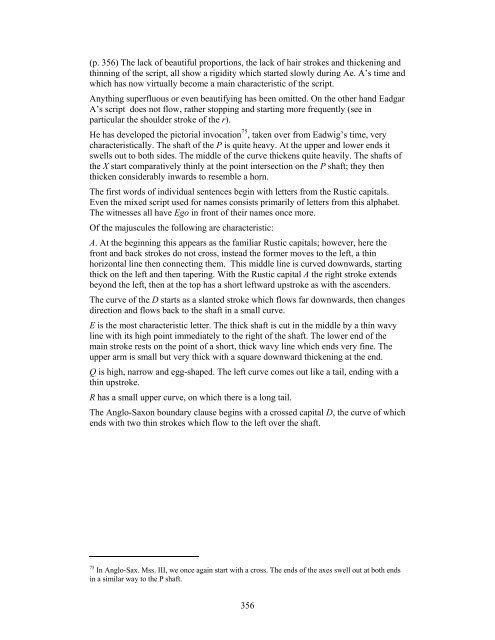Provisional Drogereit pdf
Provisional Drogereit pdf
Provisional Drogereit pdf
You also want an ePaper? Increase the reach of your titles
YUMPU automatically turns print PDFs into web optimized ePapers that Google loves.
(p. 356) The lack of beautiful proportions, the lack of hair strokes and thickening and<br />
thinning of the script, all show a rigidity which started slowly during Ae. A’s time and<br />
which has now virtually become a main characteristic of the script.<br />
Anything superfluous or even beautifying has been omitted. On the other hand Eadgar<br />
A’s script does not flow, rather stopping and starting more frequently (see in<br />
particular the shoulder stroke of the r).<br />
He has developed the pictorial invocation 75 , taken over from Eadwig’s time, very<br />
characteristically. The shaft of the P is quite heavy. At the upper and lower ends it<br />
swells out to both sides. The middle of the curve thickens quite heavily. The shafts of<br />
the X start comparatively thinly at the point intersection on the P shaft; they then<br />
thicken considerably inwards to resemble a horn.<br />
The first words of individual sentences begin with letters from the Rustic capitals.<br />
Even the mixed script used for names consists primarily of letters from this alphabet.<br />
The witnesses all have Ego in front of their names once more.<br />
Of the majuscules the following are characteristic:<br />
A. At the beginning this appears as the familiar Rustic capitals; however, here the<br />
front and back strokes do not cross, instead the former moves to the left, a thin<br />
horizontal line then connecting them. This middle line is curved downwards, starting<br />
thick on the left and then tapering. With the Rustic capital A the right stroke extends<br />
beyond the left, then at the top has a short leftward upstroke as with the ascenders.<br />
The curve of the D starts as a slanted stroke which flows far downwards, then changes<br />
direction and flows back to the shaft in a small curve.<br />
E is the most characteristic letter. The thick shaft is cut in the middle by a thin wavy<br />
line with its high point immediately to the right of the shaft. The lower end of the<br />
main stroke rests on the point of a short, thick wavy line which ends very fine. The<br />
upper arm is small but very thick with a square downward thickening at the end.<br />
Q is high, narrow and egg-shaped. The left curve comes out like a tail, ending with a<br />
thin upstroke.<br />
R has a small upper curve, on which there is a long tail.<br />
The Anglo-Saxon boundary clause begins with a crossed capital D, the curve of which<br />
ends with two thin strokes which flow to the left over the shaft.<br />
75<br />
In Anglo-Sax. Mss. III, we once again start with a cross. The ends of the axes swell out at both ends<br />
in a similar way to the P shaft.<br />
356
















